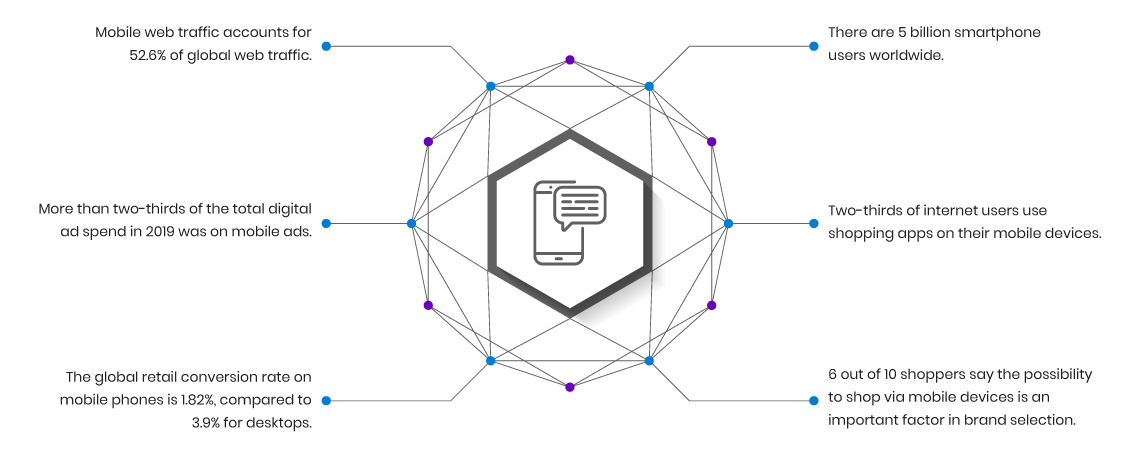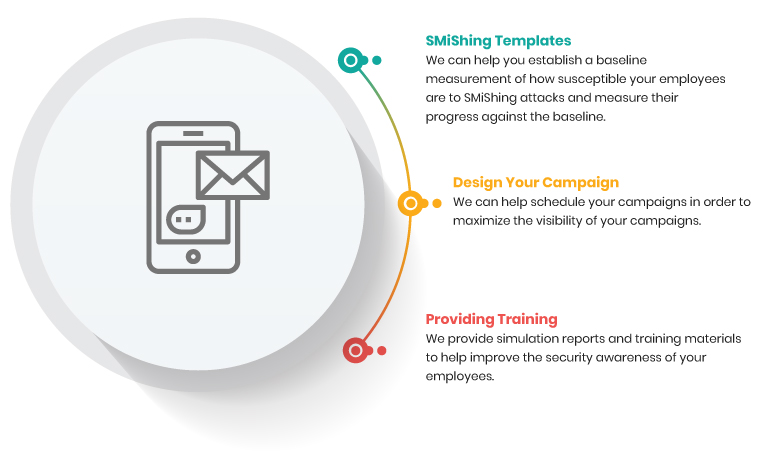SMiShing in Omaha
Ever since the global onset of the COVID-19 pandemic, workforces have gone remote and use the internet, phone networks, and other mediums to conduct business. This has made it easy for cyber attackers to target people using social engineering attacks like phishing and SMiShing, which show no signs of slowing down anytime soon.
While these threats continue to evolve in sophistication and effectiveness, enterprises in Omaha (USA) and other countries worldwide are joining hands to mitigate such destructive attacks.

+ What Is SMiShing?
SMiShing, also known as SMS Phishing, can be classified as a type of social engineering attack. Unlike email phishing, which uses emails to carry out attacks, SMiShing is done through text messages. A typical example of SMiShing is when a threat actor impersonates a legitimate entity such as your organization, an IT service/security admin, a bank, a government agency, an e-commerce site, a package delivery service, etc., to trick you into divulging your username/passwords or other sensitive information.
Although there has been an increase in awareness surrounding SMiShing scams in Omaha, the threat posed by SMiShing scams cannot be ignored because the majority of us still depend on SMS and other similar mobile applications to communicate with one another. A survey showed that in 2019, 60% of SMS users received spam messages once a week, and 28% almost every day.
What makes SMiShing scarier is that many of us tend to trust SMS messages more than email messages. The way SMiShing works is similar to that of phishing, wherein an attacker pretends to be from your bank and asks for your details or encourages you to click/visit a link to get an offer, reward, or discount. This action will enable the threat actor to obtain your sensitive data or initiate a malware download process in the background.
The year 2019 has seen a sharp rise in phishing activities, where nearly 71% of phishing attacks were financially motivated, as reported by security experts. Almost 29% of breaches involved the use of stolen credentials, and nearly 33% of breaches used social engineering. As opposed to the general assumption that large organizations are frequently targeted by phishing attacks, nearly 43% of breaches involve small-scale businesses and industries.
+ Why Is It Important to Secure a Mobile Device Against SMiShing?

These statistics show that a large number of people use a mobile device for personal and official purposes. Thus, any random mobile device has a high probability of containing sensitive data, such as financial & security information, username/password, etc. Hackers can easily exfiltrate these if they can install spyware or other malware onto the device successfully.
How to Defend Against SMS Phishing
Defending against SMiShing attacks in Omaha begins with providing simulations and awareness training to an organization’s employees to increase their security awareness surrounding such issues. To help achieve this, Aware’s SMiShing simulations are designed to test your employees in the same way a cybercriminal would and improve their understanding of the dangers associated with this threat.

Prominent Features of Aware
Along with testing and training, Aware also offers additional features based on your requirements, such as the scale of operations, campaign statistics, etc.
- Learning Management (LMS Integrations)
- Learning Management System with Autoenroll
- Priority Level Support
- Support Resources and Email Support
- Email and Phone Support
- Dedicated Consultant Support
- Customer Support
- Active Directory Support
- Multiple Language Support
- Real-Time Visible Training Results
- Campaigns Summary
- Unified Dashboard
- Advanced Reporting
- Reporting APIs
- Branded Reports
- Print & Export Reports
- Basic Reporting
- Reporting and Analytics
- Board of Directors Report
- Editable Executive Report (Word doc)
- Preset Template Library
- Customizable Template Library
- Template Creation
- Professional Template Services
- Active Phishing Threat Templates
- Education Templates
- Multiple Template Campaigns
- Schedule Real-Time Email Alerts for Campaigns
- Automated Training Campaigns
- Outlook Plugin to Report Suspicious Email
- Advanced API Integration
- Mail Server/LDAP Integration
- Active Directory Integration
- Office 365 Integration
- Exchange On-Premises Integration
- Outlook & Office Integration
- OWA Plugin
- Google Apps Integration
- Gmail Plugin
- Mobile Integration
- Priority Level Support
- Support Resources and Email Support
- Email and Phone Support
- Dedicated Consultant Support
- Customer Support
- Active Directory Support
- Multiple Language Support
- Unlimited Phishing Simulations
- Schedule Features
- Website Cloning Tool
- Industry Benchmarking
- Vishing Security Test
- SMS/Text Phishing Simulations
- Smart Groups
- Security Roles
- USB Drive Test
- Educational Content Library
- Administrative Features
- MSP Account Management
- Professional Services
- CBT Modules
- Advanced Theme Selector
- Automated Playbooks
- Advanced Analytics
- Mobile Responsive Modules
- Credentials - Data Entry
- Password Capture
- Attachments in Phishing Template
- Pre-Launch Test
- Preset Landing Page Templates
- Customizable Landing Pages
- Reporting KPIs
- Click Rate
- Opened Messages
- No Response
- Campaign History
- Repeat Offenders
- Deployment
- On-Prem
- SaaS
- Hybrid
How Often or How Long Should a SMiShing Campaign Be Carried Out?
Studies report that phishing led to a loss of $26 billion between 2016 and 2019. SMishing simulations and training are not a one-time activity. They need to be carried out regularly to ensure optimal retention and effective learning. As cybercriminals continue to ramp up their game, organizations must ensure that their employees are equipped to defend their organizations against phishing attacks. How often or how long a company must adopt and incorporate anti-phishing solutions depend on factors such as:
- The scale of operations.
- Compliance with various regulatory laws.
- The existing security infrastructure.
- Threat identification & management capability of the employee/user.
Frequently Asked Questions
Ans. Phishing is currently one of the most popular modes of delivery for malware infections, whether to steal sensitive information or gain a foothold into an organization’s network. An organization that has fallen victim to a successful phishing attack will often sustain huge financial losses, in addition to the loss of customer trust and reputational damage.